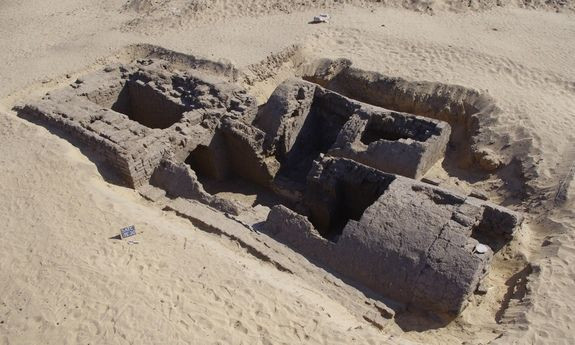3,300-Year-Old Egyptian Tomb Reveals Elaborate Burial Rites Of Ancient Elite

Ancient Egypt was known as the Gift of the Nile. For modern Egyptologists, the real gifts lie just beneath the desert surface. Archaeologists have recently uncovered an elaborate 3,300-year-old tomb that once boasted a 23-foot pyramid at its entrance. The tomb was laden with the skeletal remains of at least 15 people and housed a sandstone sarcophagus on which hieroglyphics were inscribed.
According to Live Science, the tomb was discovered at an ancient cemetery in Abydos, one of the oldest cities of ancient Egypt located about 11 kilometers, or seven miles, west of the Nile. The tomb’s many vaulted chambers would have been built below the surface, with only the pyramid visible at ground level.
“Originally, all you probably would have seen was the pyramid and maybe a little wall around the structure just to enclose everything,” Kevin Cahail, a doctoral student at the University of Pennsylvania and the tomb’s lead excavator, told Live Science. “[The pyramid] probably would have had a small mortuary chapel inside of it that may have held a statue or a stela giving the names and titles of the individuals buried underneath.”
The only part of the pyramid that remains today is the thick walls of the tomb’s entrance that would have served as the base of the pyramid.
Researchers determined that the sarcophagus, which had been painted red and depicted on its surface images of several Egyptian gods and spells from the Book of the Dead, was constructed for a scribe named Horemheb who was a general of the army under Tutankhamun. There was no mummy in the sarcophagus.
Along with the sarcophagus, excavators uncovered several ushabti figurines, which were placed in ancient tombs to act as substitutes for the deceased. They also recovered a rare heart-shaped amulet made of red and green jasper. Cahail said the amulet was probably worn on the chest of one of the deceased.
Archaeologists say the tomb was raided at least twice many years ago. Only a few artifacts and the human remains survived the lootings.
The skeletons found in the tomb – representing three to four men, 10 to 12 women and at least two children – likely belonged to members of the same two families. The presence of far more females than males would suggest polygamy, a practice that was common among Egyptian royalty.
Archaeologists believe Horemheb’s ties to the military would have allowed his family to afford a tomb with so many bells and whistles.
The tomb was excavated in the summer and winter of 2013. Cahail and his team will present the results of their study at the American Research Center of Egypt in Portland, Ore., later this week.
© Copyright IBTimes 2024. All rights reserved.






















